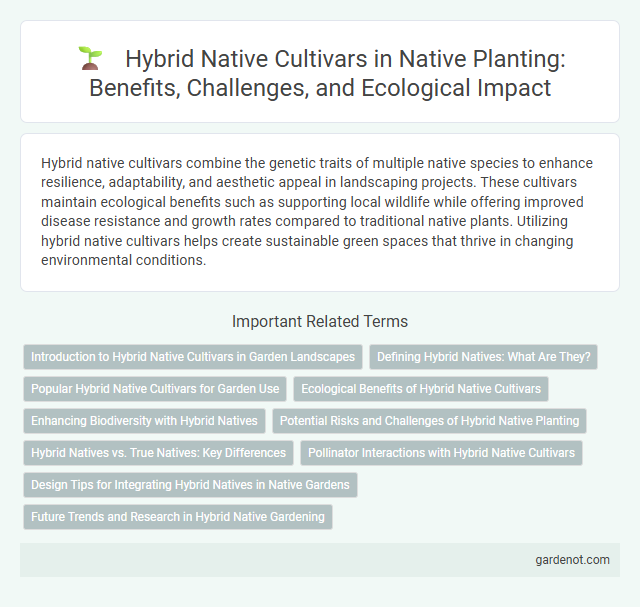Hybrid native cultivars combine the genetic traits of multiple native species to enhance resilience, adaptability, and aesthetic appeal in landscaping projects. These cultivars maintain ecological benefits such as supporting local wildlife while offering improved disease resistance and growth rates compared to traditional native plants. Utilizing hybrid native cultivars helps create sustainable green spaces that thrive in changing environmental conditions.
Introduction to Hybrid Native Cultivars in Garden Landscapes
Hybrid native cultivars combine the genetic traits of native plants with selective breeding to enhance desirable characteristics such as disease resistance, drought tolerance, and ornamental appeal. These cultivars maintain ecological benefits by supporting local wildlife and promoting biodiversity while offering gardeners improved performance and adaptability in various landscape conditions. Integrating hybrid native cultivars into garden landscapes fosters sustainable gardening practices that balance aesthetic value with environmental responsibility.
Defining Hybrid Natives: What Are They?
Hybrid native cultivars are developed by crossing two genetically distinct native plant species or varieties to combine desirable traits such as increased hardiness, disease resistance, or improved ornamental characteristics. These plants retain the ecological benefits of native species while offering enhanced adaptability to diverse environmental conditions. Unlike non-native hybrids, hybrid natives support local ecosystems by providing habitat and food sources for native wildlife.
Popular Hybrid Native Cultivars for Garden Use
Popular hybrid native cultivars for garden use combine the ecological benefits of native plants with enhanced aesthetic traits such as vibrant flower colors and increased disease resistance. Examples include the 'Firebird' Echinacea, known for its striking orange petals and adaptability, and the 'Blue Ice' Agastache, prized for its aromatic foliage and long blooming period. These cultivars support local pollinators while providing gardeners with low-maintenance and visually appealing landscape options.
Ecological Benefits of Hybrid Native Cultivars
Hybrid native cultivars provide enhanced ecological benefits by increasing plant resilience and promoting biodiversity within local ecosystems. These cultivars support native pollinators and wildlife more effectively than non-native varieties, contributing to habitat restoration and soil health improvement. Their adaptability to changing environmental conditions helps sustain ecosystem services while preserving native genetic traits.
Enhancing Biodiversity with Hybrid Natives
Hybrid native cultivars combine genetic traits from local plant species to enhance biodiversity by improving resilience and adaptability in various ecosystems. These cultivars support native wildlife, including pollinators and birds, by providing diverse habitats and food sources, which helps restore ecological balance. By integrating hybrid natives into restoration projects, land managers can accelerate the recovery of degraded habitats and promote sustainable ecosystem health.
Potential Risks and Challenges of Hybrid Native Planting
Hybrid native cultivars may pose potential risks such as genetic homogenization, which can reduce the overall biodiversity of native plant populations. They can outcompete local ecotypes, leading to the loss of unique genetic traits adapted to specific environments. Furthermore, hybrid plants may disrupt existing plant-pollinator relationships and ecosystem dynamics, challenging restoration and conservation efforts.
Hybrid Natives vs. True Natives: Key Differences
Hybrid native cultivars are selectively bred plants that combine traits from multiple native species, offering enhanced disease resistance and uniform growth compared to true natives. True natives, originating naturally in specific regions, maintain original genetic diversity crucial for ecosystem balance and support of local wildlife. While hybrids provide aesthetic and horticultural advantages, preserving true native populations is essential for sustaining native biodiversity and ecological resilience.
Pollinator Interactions with Hybrid Native Cultivars
Hybrid native cultivars often exhibit enhanced floral traits such as increased nectar production and extended blooming periods, which can attract a wider range of pollinators including native bees, butterflies, and hummingbirds. However, some studies indicate these cultivars may alter native pollinator behavior and reduce pollen diversity, potentially impacting ecosystem resilience and plant-pollinator network stability. Evaluating pollinator interactions with hybrid native cultivars is critical for balancing ecological benefits and conservation goals in native planting programs.
Design Tips for Integrating Hybrid Natives in Native Gardens
Select hybrid native cultivars that maintain ecological benefits while offering enhanced traits like drought tolerance and disease resistance to improve garden resilience. Incorporate plant diversity by combining hybrids with pure native species to support local wildlife and promote balanced ecosystems. Use strategic layering and grouping based on growth habits and bloom times to create visually appealing, seasonally dynamic native gardens.
Future Trends and Research in Hybrid Native Gardening
Hybrid native cultivars are gaining momentum as a sustainable solution in native planting, combining genetic resilience with aesthetic appeal to enhance biodiversity and habitat restoration. Ongoing research emphasizes developing hybrids with improved drought tolerance, pest resistance, and climate adaptability to address environmental challenges effectively. Advancements in genomic tools and ecological studies are driving future trends, aiming to optimize hybrid native gardening for urban landscapes and ecological conservation efforts.
Hybrid native cultivar Infographic

 gardenot.com
gardenot.com